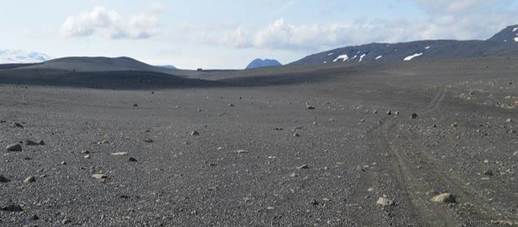The aeolian environment
The sandy deserts of Iceland cover 20 000 km2. They are unique on a global scale being dark (black) volcanogenic basalt sands. Some of the surfaces are extremely unstable, with sand flow exceeding 1000 kg crossing a metre wide line in single storms. There are certain areas that are hot spots for dust production, rating among the most active or "productive" dust sources on Earth. The dust production amounts to 30-40 million tons annually, having immense impacts on all Icelandic ecosystems and most likely on primary production in the oceans around Iceland as well. Link to review paper.
The sandy deserts often threaten vegetated systems and advancing sand fronts are responsible for a large part of ecosystem destruction in Iceland since the settlement (about 870 AD). They pose a huge challenge for reclamation activities. Iceland has one of the oldest soil conservation conservation in the world, established in 1907 to fight sand encroachment (The Icelandic Soil Conservation Service).
The deserts are quite aesthetic in their own rights, yet they are hostile environments with intense frost action in winter, fluvial processes (impeded infiltration in winter), wind erosion with severe sand abrasion, and rapid evaporation on sunny summer days with the surface heating up to >40°C. Icelandic deserts and desert surface processes have been used as analogue for conditions on the planet Mars (see references on this sub-page).
There is ample rainfall in many of the desert areas. They are interesting in the context of the definition of a desert and desertification. Icelandic deserts show that it is they fate of the water and other ecosystem characteristics that determine what makes barren areas, not the rainfall category, which often are used to define deserts and desertification. LINK
The sandy deserts often threaten vegetated systems and advancing sand fronts are responsible for a large part of ecosystem destruction in Iceland since the settlement (about 870 AD). They pose a huge challenge for reclamation activities. Iceland has one of the oldest soil conservation conservation in the world, established in 1907 to fight sand encroachment (The Icelandic Soil Conservation Service).
The deserts are quite aesthetic in their own rights, yet they are hostile environments with intense frost action in winter, fluvial processes (impeded infiltration in winter), wind erosion with severe sand abrasion, and rapid evaporation on sunny summer days with the surface heating up to >40°C. Icelandic deserts and desert surface processes have been used as analogue for conditions on the planet Mars (see references on this sub-page).
There is ample rainfall in many of the desert areas. They are interesting in the context of the definition of a desert and desertification. Icelandic deserts show that it is they fate of the water and other ecosystem characteristics that determine what makes barren areas, not the rainfall category, which often are used to define deserts and desertification. LINK
